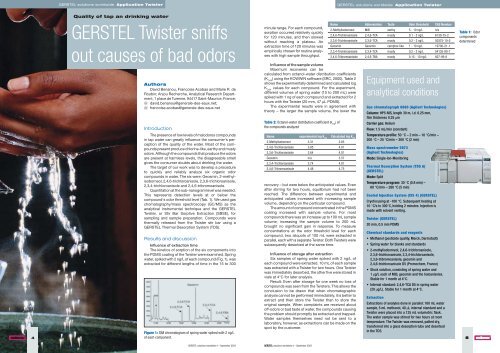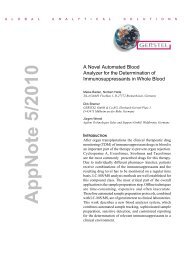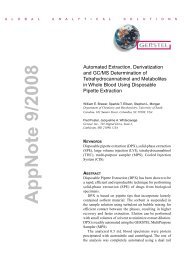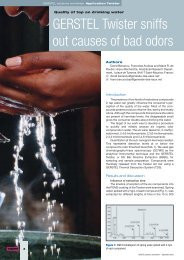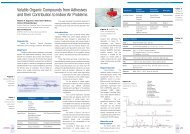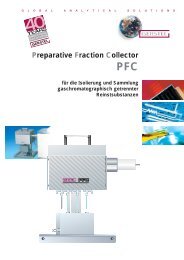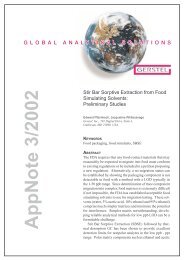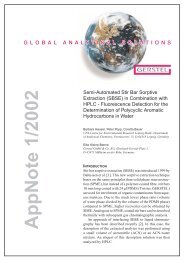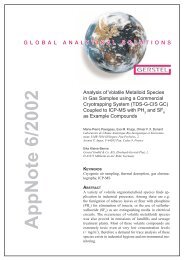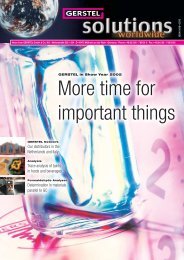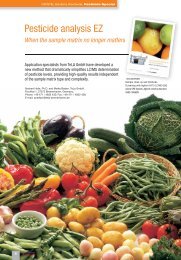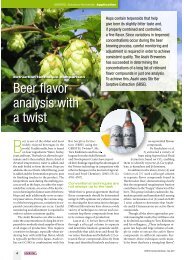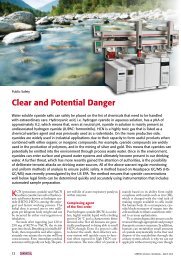GERSTEL Solution no 4
GERSTEL Solution no 4
GERSTEL Solution no 4
You also want an ePaper? Increase the reach of your titles
YUMPU automatically turns print PDFs into web optimized ePapers that Google loves.
<strong>GERSTEL</strong> solutions worldwide Application Twister<br />
<strong>GERSTEL</strong> solutions worldwide Application Twister<br />
Quality of tap an drinking water<br />
<strong>GERSTEL</strong> Twister sniffs<br />
out causes of bad odors<br />
minute range. For each compound,<br />
sorption occurred relatively quickly<br />
for 120 minutes, and then slowed<br />
without reaching a plateau. An<br />
extraction time of 120 minutes was<br />
empirically chosen for routine analyses<br />
with high sample throughput.<br />
Name Abbreviation Taste Odor threshold CAS Number<br />
2-Methylisoborneol MIB earthy 5 - 10 ng/L n/a<br />
2,4,6-Trichloroanisole 2,4,6-TCA musty 0.1 - 2 ng/L 6130-75-2<br />
2,3,6-Trichloroanisole 2,3,6-TCA musty 0.2 - 2 ng/L 50375-10-5<br />
Geosmin Geosmin camphor-like 1 - 10 ng/L 19700-21-1<br />
2,3,4-Trichloroanisole 2,3,4-TCA musty 0.2 - 2 ng/L 54135-80-7<br />
2,4,6-Tribromoanisole 2,4,6-TBA musty 0.15 - 10 ng/L 607-99-8<br />
Table 1: Odor<br />
components<br />
determined<br />
4<br />
Authors<br />
David Bena<strong>no</strong>u, Francoise Acobas and Marie R. de<br />
Roubin; Anjou Recherche, Analytical Research Department,<br />
1 place de Turenne, 94417 Saint-Maurice, France;<br />
david.bena<strong>no</strong>u@generale-des-eaux.net;<br />
francoise.acobas@generale-des-eaux.net<br />
Introduction<br />
The presence of low levels of malodoros compounds<br />
in tap water can greatly influence the consumer‘s perception<br />
of the quality of the water. Most of the compounds<br />
present produce chlorine-like, earthy and musty<br />
odors. Although the compounds that produce the odors<br />
are present at harmless levels, the disagreeable smell<br />
gives the consumer doubts about drinking the water.<br />
The target of our work was to develop a procedure<br />
to quickly and reliably analyze six organic odor<br />
compounds in water. The six were: Geosmin, 2-methylisoborneol,<br />
2,4,6-trichloroanisole, 2,3,6-trichloroanisole,<br />
2,3,4-trichloroanisole and 2,4,6-tribromoanisole.<br />
Quantitation at the sub-na<strong>no</strong>gram level was needed.<br />
This represents detection levels at or below the<br />
compound‘s odor threshold level (Tab. 1). We used gas<br />
chomatography/mass spectroscopy (GC/MS) as the<br />
analytical instrumental technique and the <strong>GERSTEL</strong><br />
Twister, or Stir Bar Sorptive Extraction (SBSE), for<br />
sampling and sample preparation. Compounds were<br />
thermally released from the Twister stir bar using a<br />
<strong>GERSTEL</strong> Thermal Desorption System (TDS).<br />
Results and discussion<br />
Influence of extraction time<br />
The kinetics of sorption of the six components into<br />
the PDMS coating of the Twister were examined. Spring<br />
water, spiked with 2 ng/L of each compound (Fig. 1), was<br />
extracted for different lengths of time in the 15 to 300<br />
Figure 1: SIM chromatogram of spring water spiked with 2 ng/L<br />
of each component.<br />
Influence of the sample volume<br />
Maximum recoveries can be<br />
calculated from octa<strong>no</strong>l-water distribution coefficients<br />
(K O/W<br />
) using the KOWWIN software (SRC, 2000). Table 2<br />
shows the experimentally determined and calculated log<br />
K O/W<br />
values for each compound. For the experiment,<br />
different volumes of spring water (10 to 200 mL) were<br />
spiked with 1 ng of each compound and extracted for 2<br />
hours with the Twister (20 mm, 47 µL PDMS).<br />
The experimental results were in agreement with<br />
theory – the larger the sample volume, the lower the<br />
Table 2: Octa<strong>no</strong>l-water distribution coefficient (K O/W<br />
) of<br />
the compounds analyzed<br />
Name experimental log K OW<br />
Calculated log K OW<br />
2-Methylisoborneol 3.31 2.85<br />
2,4,6-Trichloroanisole 3.85 4.01<br />
2,3,6-Trichloroanisole 3.64 4.01<br />
Geosmin n/a 3.57<br />
2,3,4-Trichloroanisole 3.74 4.01<br />
2,4,6-Tribromoanisole 4.48 4.75<br />
recovery – but were below the anticipated values. Even<br />
after stirring for two hours, equilibrium had <strong>no</strong>t been<br />
reached. The difference between experimental and<br />
anticipated values increased with increasing sample<br />
volume, depending on the particular compound.<br />
The amount of compound concentrated in the PDMS<br />
coating increased with sample volume. For most<br />
compounds there was an increase up to 100 mL sample<br />
volume; increasing the sample volume to 200 mL<br />
brought <strong>no</strong> significant gain in response. To measure<br />
concentrations at the odor threshold level for each<br />
compound, two aliquots of 100 mL were extracted in<br />
parallel, each with a separate Twister. Both Twisters were<br />
subsequently desorbed at the same time.<br />
Influence of storage after extraction<br />
Six samples of spring water spiked with 2 ng/L of<br />
each compound were extracted. 10 mL of each sample<br />
was extracted with a Twister for two hours. One Twister<br />
was immediately desorbed, the other five were stored in<br />
vials at 4°C for later analysis.<br />
Result: Even after storage for one week <strong>no</strong> loss of<br />
compounds was seen from the Twisters. This allows the<br />
conclusion to be drawn that when chromatographic<br />
analysis can<strong>no</strong>t be performed immediately, it is better to<br />
extract and then store the Twister than to store the<br />
original sample. When complaints are received about<br />
off-odors or bad taste of water, the compounds causing<br />
the problem should promptly be extracted and trapped.<br />
Water samples themselves need <strong>no</strong>t be sent to a<br />
laboratory, however, as extractions can be made on the<br />
spot by the customer.<br />
Equipment used and<br />
analytical conditions<br />
Gas chromatograph 6890 (Agilent Tech<strong>no</strong>logies)<br />
Column: HP5-MS, length 30 m, i.d. 0.25 mm,<br />
film thickness 0.25 µm<br />
Carrier gas: Helium<br />
Flow: 1.5 mL/min (constant)<br />
Temperature profile: 50 °C – 2 min – 10 °C/min –<br />
200 °C – 25 °C/min – 300 °C (2 min)<br />
Mass spectrometer 5973<br />
(Agilent Tech<strong>no</strong>logies)<br />
Mode: Single-Ion-Monitoring<br />
Thermal Desorption System (TDS A)<br />
(<strong>GERSTEL</strong>)<br />
Mode: Split<br />
Temperature program: 30 °C (0.8 min) –<br />
60 °C/min – 280 °C (5 min)<br />
Cooled Injection System (CIS 4) (<strong>GERSTEL</strong>)<br />
Cryofocusing at -100 °C. Subsequent heating at<br />
10 °C/s to 300°C, holding 2 minutes. Injection is<br />
made with solvent venting.<br />
Twister (<strong>GERSTEL</strong>)<br />
20 mm, 0.5 mm PDMS<br />
Chemical standards and reagents<br />
• Metha<strong>no</strong>l (pesticide quality, Merck, Darmstadt)<br />
• Spring water for blanks and standards<br />
• 2-methylisoborneol, 2,4,6-trichloroanisole,<br />
2,3,6-trichloroanisole, 2,3,4-trichloroanisole,<br />
2,3,6-tribromoanisole, geosmin and<br />
2,4,6-trichloroanisole D5 (Promochem, France)<br />
• Stock solution, consisting of spring water and<br />
1 µg/L each of MIB, geosmin and the haloanisoles.<br />
Stable for 1 month at 4°C.<br />
• Internal standard: 2,4,6-TCA D5 in spring water<br />
(20 µg/L). Stable for 1 month at 4°C.<br />
Extraction<br />
Extractions of analytes done in parallel: 100 mL water<br />
sample, 5 mL metha<strong>no</strong>l, 40 µL internal standard and a<br />
Twister were placed into a 125 mL volumetric flask.<br />
The water sample was stirred for two hours at room<br />
temperature. The Twister was removed, patted dry,<br />
transferred into a glass desorption tube and desorbed<br />
in the TDS.<br />
5<br />
<strong>GERSTEL</strong> solutions worldwide 4 – September 2003<br />
<strong>GERSTEL</strong> solutions worldwide 4 – September 2003


